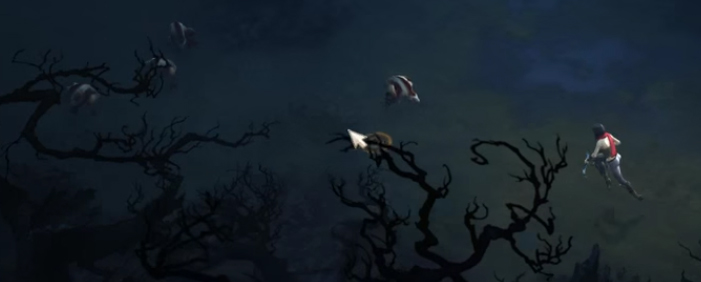
Act 1 of Diablo 3, particularly the first half leading up to the death of the Skeleton King is exceptionally well structured and “paced” with the introduction of monsters and concepts. New elements are introduced, tested, and compounded before you are then thrown into the depths to find and fight the Skeleton King.
The game begins simply. First, you see a corpse. A clear, bloody, warning.

Then you see a zombie eating a corpse.

Then you come to a barricaded town, littered with corpses. The living are there too, and the zombies attack. New zombies (crawling torsos) pop out in the second or third wave as a surprise escalation.

When you win, you go into town. The living are scared, and then omg some of the living transform into zombies!!!!

The living speculate there is a source. “Wretched mothers” and a “queen” that are supposedly the source of these zombies. You return to the barricade, part of it breaks apart as zombies, led by one of these wretched mothers attacks.

You go to seek the source of this problem. Now that you’ve been exposed to all the types of zombies, you are tested along the road by them. Basic zombies. Big zombies that can fall apart and become a torso only zombie, mothers who spawn in more basic zombies.
A new monster, Quillboars, can be found along the road, but they almost always found off the road near the extreme edge of the map. So if you stick to the road you will likely not see any until you get to the ruins of Old Tristram. You may also encounter elite versions of the Quillboar first, looting the cellar of an abandoned home. They are inserted as if they are a more “natural” type of monster that has been pushed to the fringes due to the current zombie apocalypse.
Then, you reach the Ruined Cathedral and are presented with a clear descent into the mythic underworld.

Zombies first, but they are known (feeding upon a corpse) and you are introduced to a new mechanic of being able to use the dungeon against the monsters (falling chandelier). At this point, because a descent into another world has happened, most of the additional monsters are just kinda there and will be encountered at random. There is not a set introduction for these fresh horrors (skeletons, flying imp type creatures, big exploding horrors, leaches from inside the big exploding monsters).

Skeletons with shields are introduced, chasing the NPC you have come to the Cathedral to find, but they are immediately killed by falling rocks.

The ghost of the Skeleton King then appears, introduces himself officially (you may have found a few books about him on the 1st level of the Cathedral) and proceeds to demonstrate how he can “warp in” skeletons to fight on his behalf.

Then we get a town break/info dump/go help the blacksmith who’s wife becomes a zombie. Kill the blacksmith’s wife and he sends you off to find the crown you’ll need to destroy the Skeleton King.
Upon entering the next section, you’re basically immediately rushed by demon dogs.

All other monsters have been met before, and the focus remains on zombies (dead rising). You come to a graveyard, pass through the mass graves where the zombies rise to get you, and then reach 3 crypts, and smaller graveyard. The dead coming up out of the ground change from zombies to skeletons here perhaps due to association with the Skeleton King? You know the crown can be found in one of the crypts, but which…?

Again, entering into a new underworld seems to automatically indicate that new stuff should be expected. In addition to the previous monsters, you get a couple types of ghost, and imps that run around like corrupted children. Once you find the correct crypt however, you get one of the best monster introductions in the game. In an empty crypt, there is a large sealed door, like those seen in the Cathedral, and as you get close the door begins to move and you can hear heavy banging, and then BAM! A giant undead abomination pops out to get you.

On the other side of this door, another new monster, typically introduced (but not guaranteed to be) by its laughter from the darkness. A skeleton, surrounded by an aura of magic that has an appearance similar to the Skeleton King, that warps in skeletons. Visual connectedness and similar behaviors build on each other with each new introduction.
With the crown recovered and then repaired, you then return to the Ruined Cathedral where all of these monsters appear. Their introductions are over, the “test” begins, can you defeat the Skeleton King?
Obviously this is all pretty “linear” and “video gamey” but hey, it was made for a linear video game! Still, I think the guts are solid, and they jive well with other things we’re seeing in the OSR scene, such as Skerples Tomb of the Serpent Kings with its focus on “lessons” taught to you by direct interaction with the dungeon, and Chris McDowell’s “Three Step Dungeons” post that dropped today.




 The answer is pretty much: RSS Feeds. And there are lots of solutions, but I want to talk about
The answer is pretty much: RSS Feeds. And there are lots of solutions, but I want to talk about 